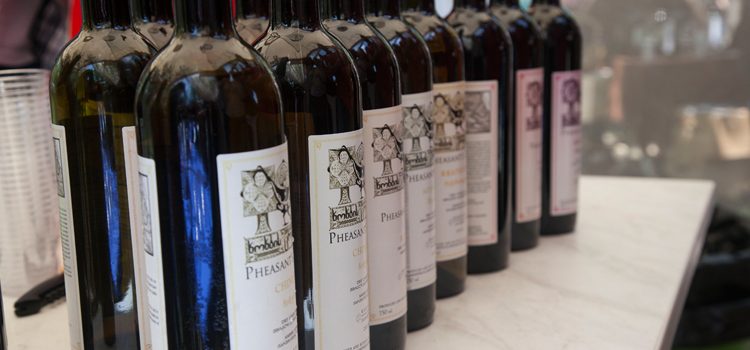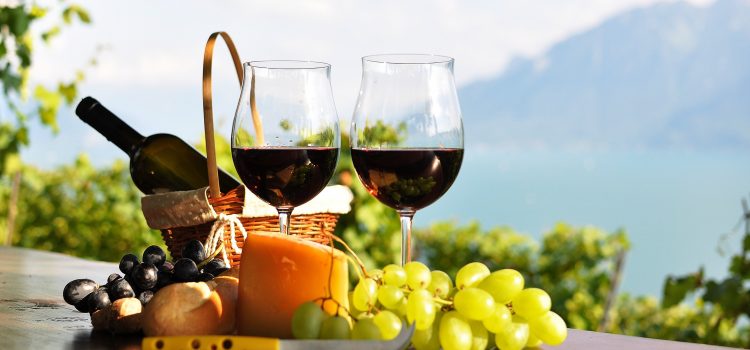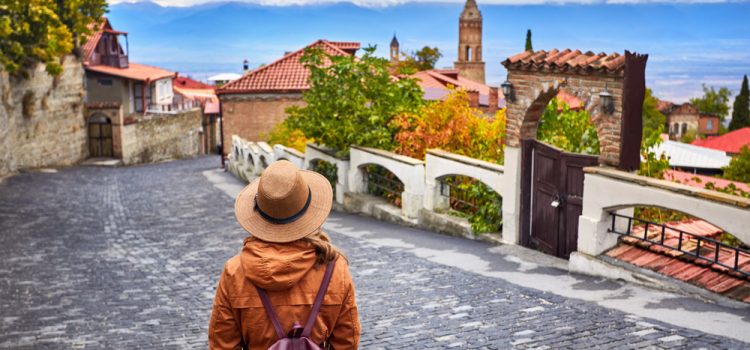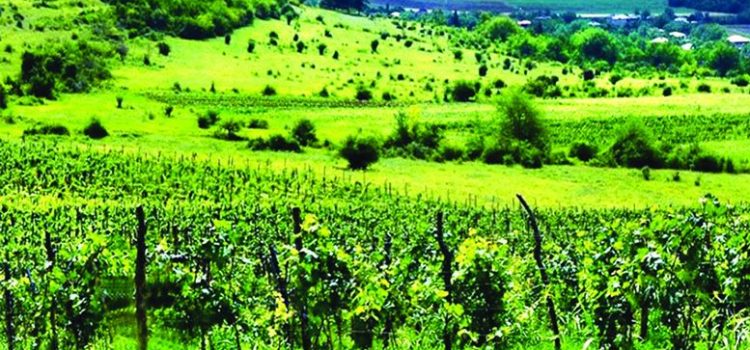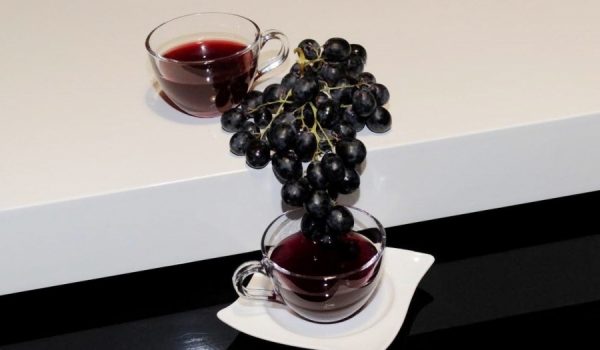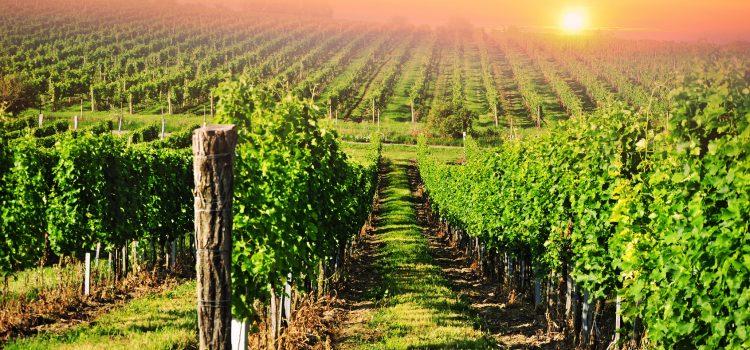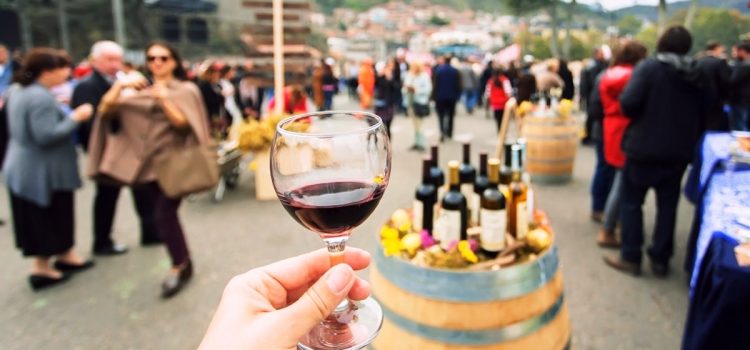Georgia plans to increase wine exports to Japan
Georgian Agriculture Minister Levan Davitashvili and President of Japanese alcoholic drinks consultation company ASIA AC Wataru Iwamoto met yesterday to discuss the prospect of exporting more Georgian wine to the Japanese market.
Wataru Iwamoto stated that Georgian wine is in high demand on the Japanese market after the ‘Georgia – Homeland of Wine’ exhibition was held.
Minister Levan Davitashvili said he hopes the partnership with the Japanese market will be fruitful.
The employees of the Asia AC company will have a two-day tour in Tbilisi and Kakheti region to taste different varieties of Georgian wine.
Source: www.agenda.ge, photo source: www.agenda.ge
Georgian Wine Presented in US Cities
Georgian wine, one of the major parts of the ancient culture of Georgia, has yet another time moved beyond the borders of its homeland. This time, it has been introduced to wider audiences in the USA, in the cities of New York, Chicago and Boston in particular.
At a presentation given by the top-sommelier Taylor Parsons and attended by Georgian wine producers, local entrepreneurs and media representatives, guests were given an opportunity to taste the wine and listen to a seminar on the modern wine industry.
The National Wine Agency of Georgia, the financial supporter of the event, selected the USA as a strategic and promising market for exporting Georgian wine. 354,000 bottles of wine were exported to the USA in the first half of 2019, which is a 90% increase in comparison with the same time period of the last year.
The presentation in the US cities was organized by the contractor marketing company of the National Wine Agency Marq Energie Consulting.
Source: www.georgiatoday.ge; By Ketevan Kvaratskheliya
Image source: National Wine Agency
Georgia’s Historic Gem: Sighnaghi, The City of Love
Sighnaghi is a charming little town to the east of Tbilisi, located at an altitude of 740 meters above sea level. The town offers scenic views of the Alazani Valley and the Great Caucasian ridge, but not only this: Sighnaghi and its surroundings are being developed rapidly with more and more attractions popping up by the year.
When I first went to Sighnaghi in 2010, the town was already in the process of being restored. But even back then, a visit to Sighnaghi was a great experience in itself, taking into account its great historic wall, Sighnaghi National Museum, which houses a number of great masterpieces of Niko Pirosmani, and the town’s location close to the famous pilgrims’ destination, the Bodbe Monastery.
In 2010, Sighnaghi, in terms of infrastructure, didn’t have much to offer visitors aside from its great panoramic views and a few newly refurbished central streets. It had a few restaurants, one hotel and a couple of guesthouses. The rest of the town, with its crumbling facades, rusty roofs and pot-holed roads, reminded one heavily of a Potemkin village.
Since then, many things have changed. The city’s appearance, its roads, facades, and infrastructure have been restored or renovated; and throughout the town numerous restaurants and guesthouses have been established. Tourists from all over the world, including China, South Korea and Japan, now stream to Sighnaghi, meaning you’ll be hard put to find a household there which is not somehow involved in the tourism business.
“When I registered my guesthouse in the Booking.com system three years ago, I was the 34th on the list of Sighnaghi accomodation,” said Roman Beghashvili, a Sighnaghi guesthouse owner. “Now, there are around 150 on the list.”
Competition drives those in tourism to make their places more attractive to tourists. The ideas vary and are sometimes rather eccentric. There are plenty of picturesque cafés and hotels built beside the historic Sighnaghi wall. One of them, for instance, located on high stilts, seems to be hovering over the town, and offers guests the chance to take a paraglider flight or enjoy a drink overlooking the Alazani Valley and the historic wall, which is more than 4 km long. I’ve only had one comparable view of a medieval wall, and that was in the historic city of Avila in Spain.
“The first reminiscences of our town wall were found in chronicles of the 13th century,” said Mariam Guliashvili, the town historian. “But the construction of the wall which you can see now was ordered in the 18th century by King Irakli II. Our enemies used to attack our villages in the Alazani Valley: from the north came the Lezgins, from the south the Persians. They stole our women, children and livestock in order to sell them into slavery. To protect the inhabitants of the valley from the intruders, King Irakli II gave the order to construct this wall, which according to different documents was between 5 and 7 km long and had 23 towers and eight gates. Now we have over 4.5 km of it left, which comes close to the Small Wall of China with its 5 km length.”
Sighnaghi received its “city” status in 1770. At that time, it was already a vivid town of workmanship and trade with a population of up to 10,000 people, the majority being of Armenian origin. The King had ordered the Armenians to settle in Sighnaghi, as the Alazani Valley had previously been devastated by Shah Abbas, who took 100,000 Georgians to Persia.
In the following centuries, Sighnaghi became a great cultural and educational center, with its own theater and schools. Girls were educated in private schools established in the houses of rich citizens. In Soviet times, Sighnaghi was a flourishing tourist attraction with a big hotel located close to the town. The town was proud of its own Ethnographic Park, where archeologists from all over the country worked together on excavations. You still can visit this area now, if you take a walk in the beautiful and newly restored town park, which is romantically located on the slopes of Sighnaghi, behind the wall. Also worth a visit is the local cemetery, bearing many exciting stories of past times. With a little imagination, you can see the town history right there.
In order to inquire about recent tendencies in tourism, I headed to the Sighnaghi Information Center. The officer, Zurab Siprashvili, told me that just 10% of those who come to Sighnaghi actually visit the Information Center. He put the number of tourists that visited Sighnaghi last year at around 11,000 people, with the trend growing by the year. Most of the tourists come from Russia, Poland, Germany, France and Israel.
Sighnaghi’s location on a hill high above the ancient winemaking valley contributes to its increasing popularity. There are four big wineries as well as many wine degustation points in Sighnaghi.
From the town’s Deputy Mayor, Madonna Batiashvili, I learned about further plans concerning tourism and further development of the Sighnaghi region. “In future, we want our guests to stay longer in our region, so we plan to develop the nearby villages of Tsnori and Machkhaani. The latter is a unique village with an old theater from the 19th century and many historic houses, which are quite different from the usual Kakhetian houses. Machkhaani will soon be given the status of a Museum Village,” Batiashvili noted.
The town council plans to establish a new tourist route connecting Sighnaghi, Tsnori, Machkhaani and proceeding to Dedoplitskharo, a city with its own Pirosmani museum. Investments should be made in agricultural tourism for those visitors who enjoy nature, hunting and fishing, and who want to learn more about making churchkhela and baking Georgian bread. Several cable car routes should be established in order to connect some villages and allow visitors to enjoy great views of the Alazani Valley.
What else makes Sighnaghi so attractive for tourists? One of the town’s most renowned attractions is a quick marriage in the Marriage House, which operates 24/7.
“All you need is your passport and two witnesses,” Batiashvili told us. “Just imagine: I recently met a couple who became husband and wife early in the morning, at 4 am!”
Indeed, getting married is easy in Sighnaghi, as you don’t need to deal with bureaucracy at all. “Many of our citizens have become witnesses already, and they are now treated as relatives by the families of the newly married couples,” Batiashvili proudly said.
Source: www.Georgiatoday.ge; By Tatiana Montik
Why Georgian-Danish couple prefers living in Georgia to the USA?
Eka Chvritidze and his Danish husband Olaf Malver own their wine company “Danieli Winery”. Eka had to pass a long way before launching a wine company.
Eka comes from Tusheti, Georgia’s mountain resort. She started to study at a Georgian school and then moved to the US. After finishing up the school in America, she managed to gain a 50% scholarship for a University. However, Eka knew she wanted to settle down in Georgia and came back. In Georgia, she graduated from the faculty of International Business and Foreign Trade at a local university and started working at one of the NGOs. This stage of life was a breaking point for her – she realized she’d better take care of cows and produce cheese in Tusheti than do tasks given by the boss.
Because of her Danish husband Olaf Malver, the couple had to live in California for 7 years. Olaf’s parents were collectors of French and Italian wines and he was also interested in wine production. Eka decided to make his dream come true and bought land in Georgia for a vineyard. In 2012, they returned to Georgia and a year later, they already started to produce wine. “Danieli Winery” produces Rkatsiteli, Kisi, Saperavi and qvevri wine.
The couple exports their wine to America, Ukraine, and Scandinavia. They do not plan to involve more countries but to focus more on quality.
Source: Georgianjournal.ge, Photo: Georgianjournal.ge
Georgian Wines Evening Held in Italy
Tasting of Georgian Qvevri wines at an event titled “The Beginning of Everything” was offered in Italy in cooperation with the Embassy of Georgia in Italy, the Rome Sommelier Association ‘Divinamente Roma’ and Georgian National Wine Agency (NWA), the Ministry of Foreign Affairs of Georgia reports.
Konstantine Surguladze, Ambassador Extraordinary and Plenipotentiary of Georgia to Italy, addressed the audience with a welcome speech, emphasizing the special cultural significance of Georgian winemaking and speaking about Georgian history, traditions and culture.
At the event, representative of the NWA Giorgi Tevzadze introduced the ancient history of Georgian wine and winemaking technology in Qvevri. Four different kinds of Qvevri wine were presented for tasting. Together with Georgian wines, visitors tasted Qvevri wines made by Italian and Greek winemakers, including ‘Ribola’ by Yosko Gravner, a prominent Italian winemaker and pioneer of Georgian Qvevri and Georgian technology in Europe, which was introduced by his daughter Matteia Gravner.
The event was attended by sommeliers, Italian wine-producing companies and media representatives.
Source:Georgiatoday.ge, By Mariam Merabishvili
Wine Tea – Brilliant Georgian Innovation
‘Wine Tea’ project is the winner of Startup Georgia state program. One of its authors is Giorgi Bukia, who says that the idea to produce wine tea belongs to a pharmacologist named Irakli Natroshvili, who was making a research on the beneficial characteristics of red wine (Saperavi) 25 years ago.
He says various kinds of experiments were carried out and as a result, a loose mass obtained was named a wine tea. Bukia also says this project had been left unattended for years and 2 years ago Irakli Natroshvili’s son Giogi Natroshvili decided to revive it. He brought the project to Giorgi Bukia and they presented it to the Startup Georgia program. As the author of the project says, there are several stages of wine processing and the resulted loose mass is packaged. As for the preparation, it is not any different from the regular tea.
According to him, there are only experimental samples of products today – serial production will start from November when the enterprise is finished. The search for the place to set up the enterprise is taking place currently and presumably it will be located in Kakheti region of eastern Georgia. At the initial stage the product will be sold on the local market. In addition, the samples were sent to Ukraine and Russia. Giorgi Bukia believes that there is a prospect of wine tea in Muslim countries as well where alcohol is prohibited but they love the aroma of wine.
One of the authors of the project plans to develop other Georgian varieties of wine in future, but at this stage the focus is on Saperavi. “Wine Tea” will be marketed by “Amato” brand. According to Giorgi Bukia, they plan close cooperation with wine companies and tea producers in the future. The “Wine Tea” project was funded by Startup Georgia project with 100 thousand Georgian laris.
Source: Allwine.ge, Photo: Georgianjournal.ge
Caucasus Wine University to be opened in Gurjaani
In the Kakheti region a new viticulture campus of the Caucasus University is in the process of planning. Although, no details about the opening date have been communicated so far, the Wine University is supposed to offer vocational, bachelor and master programs to students.
Davit Songhulashvili, member of Parliament and Gurjaani Majoritarian said: “The decision on the launch of the wine school in Kakheti region was made by the Caucasus University based on the
study, conducted by the university. I had the same initiative earlier. Our plans coincide with each other and the process was speeded up. Today, the Free University is the only university in Georgia, which involves the agrarian direction and it is located in Tbilisi. Kakheti is the region of viticulture and winemaking and consequently, such a university is very important here. ”
Indeed Gurjaani has a long tradition of wine and viticulture. The small town is located in the fertile Alazani River Plain and is surrounded by vineyards. From Tbilisi, it takes two hours by car, to reach the city in Kakheti.
There has recently been an increased push by the Georgian government to professionalize the national wine industry, particularly to strengthen export possibilities to the European Union and beyond. Although the Georgian wine history is 8,000 years old and 500 out of total 2000 known varieties in the world is Georgian, this direction is not sufficiently cared in terms of professional development, states also the wine industry.
Source: Georgianjournal.ge
Wine on Mars? The World’s Oldest Wine-Making Country Wants to Make It Happen
The first human colonists on Mars will have to forgo many of the creature comforts of Earth — things like enjoying an ozone layer, for example, or opting out of rearing genetically engineered Martian babies. Fortunately, one essential earthly amenity these hardscrabble colonists may not have to give up is wine.
Georgia, a country with an 8,000-year-old viticulture tradition, is putting its top space and wine scientists to work figuring out how to grow grapes on Mars.
The project, named IX Millennium, ostensibly as a nod to Georgia’s ninth millennium making wine, will involve several phases of research into building an agricultural infrastructure on Mars. One critical step: identifying the grape varietals on Earth best equipped to withstand the harsh radiation, fearsome dust storms and severe temperature swings of the Red Planet. This research could help hydrate permanent settlements on Mars a soon as 2024 — the year when SpaceX founder Elon Musk intends to launch the first crewed mission there. (NASA hopes to follow in the 2030s.) [Mars InSight Photos: A Timeline to Landing on the Red Planet]
“If we’re going to live on Mars one day, Georgia needs to contribute,” Nikoloz Doborjginidze, founder of Georgia’s Space Research Agency and an adviser on the wine project, told The Washington Post. “Our ancestors brought wine to Earth, so we can do the same to Mars.” (The origins of wine are still debated, but Georgia holds a valid claim thanks to their recent discovery of an old wine-stained pot dated to 6000 B.C.)
The first wine on Mars
The new space wine project will kick off later this year with the installation of “vertical greenhouses” inside a hotel in the capital city of Tbilisi, according to Georgian news agency Agenda.ge. There, floor-to-ceiling pods of soil and seeds (including grapes, strawberries and arugula) will be left to grow under hydroponic lights with minimal human interference, simulating the possible conditions of a controlled agriculture pod on Mars.
In the meantime, Georgian wine experts are hard at work trying to figure out which grape varietals might best survive harsh Martian conditions. Over the next few years, researchers at Tbilisi’s Business Technology University plan to simulate a Martian environment in the laboratory, exposing soil samples to subzero conditions, high carbon monoxide levels and thin air meant to mimic the atmospheric pressure at “20,000 feet [6,000 meters] altitude on Earth,” The Washington Post reported.
These experiments likely will not bear fruit until at least 2022, but scientists already have a hunch that white wine will fare best on the Red Planet.
“Whites tend to be more resistant to viruses,” Levan Ujmajuridze, director of Georgia’s vineyard Laboratory, told The Washington Post. “So, I’d imagine they’ll do well against radiation, too. Their skin could reflect it.”
These experiments could well provide future Martians with grapevines — but the actual fermenting, bottling and aging would be up to them. Nobody knows exactly how fermenting grapes in microgravity will actually work yet, but NASA scientists think it’s possible.
The Georgia team’s boozy experiments aren’t the first foray into space agriculture. Astronauts aboard the International Space Station (ISS) have already begun growing salad crops in microgravity, while China’s recently deployed Chang’e-4 lander will attempt to grow potatoes and rockcress (a flowering plant similar to cabbage and mustard) on the moon.
The makers of Budweiser, meanwhile, have launched barley seeds into space three times in hopes of becoming “the first beer on Mars,” while a batch of Ardmore scotch whisky spent three years aboard the ISS from 2011 to 2014. That project showed Earthlings that even an old drop of the pure is apparently not immune to the ravages of microgravity; the scotch reportedly came home tasting of “antiseptic lozenges” and “rubbery smoke.”
Originally published on Live Science.
Source: www.Space.com

